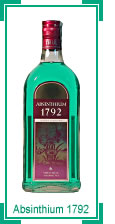Absinthe: attention performance and mood under the influence of thujone. : An article from: Journal of Studies on Alcohol
Objective: The aim of this study was to determine whether the impacts of absinthe on attention performance and mood were different from those experienced with beverages that contain only alcohol. The ingredient causing absinthe’s toxicity is believed to be thujone. Method: A total of 25 healthy subjects participated in the study. An attention performance test and two questionnaires testing different mood dimensions were used. Three drinks with an identical amount of alcohol but with different amounts of thujone were offered. Results: The results of the present study showed that the simultaneous administration of alcohol containing a high concentration of thujone had a negative effect on attention performance. Under this condition, the subjects tended to direct their attention to signals in the central field of attention and to neglect peripheral signals; the number of correct reactions decreased significantly in the peripheral field of attention, and reaction time and the number of “false alarm” reactions increased significantly. The effects were most prominent at the time of the first measurement. When the subjects were under the influence of alcohol or were administered both alcohol and a low thujone concentration, these effects were not observed. The assessment of mood state dimensions showed that the anxiolytic effect of alcohol was temporarily counteracted by a high thujone concentration. Conclusions: As they are apparently opposed to the effect of alcohol, the reactions observed here can be explained by the antagonistic effect of thujone on the gamma-aminobutyric acid receptor. Similar alterations were observed for the other mood state dimensions examined.
Seems pretty clear to me 🙂












I’m curious, what sounds clear?
It should be mentioned the “high thujone” concentration was much higher than the majority of absinthe or wormwood bitters and even then only a small number of subjects could tell they were drinking the ‘high thujone’ sample.
Yes, its always the fault of the science when they reach a conclusion that doesn’t suit your agenda.
Ari says: “high thujone” concentration was much higher than the majority of absinthe”
Big Daddy has made the following comments regarding thujone levels in absinthe, which means that this position is questionable:
“Thujone testing is VASTLY less reliable and more dependent on lab to lab variations than is commonly realised. The enforcement of thujone limits by regulatory authorities is so lax as to be almost non-existent. In some jurisdictions it IS non existent. The actual thujone content of many (anecdotally, I think most) absinthes isn’t the figure quoted on the bottle”
It all depends on whether you take the view that the thujone levels are higher or lower than those quoted.
Drabsinthe said, “Yes, its always the fault of the science when they reach a conclusion that doesn’t suit your agenda.”
Where did you get that?
What do you think their conclusion is and how does it not suit my ‘agenda’?
Drabsinthe said, “It all depends on whether you take the view that the thujone levels are higher or lower than those quoted.”
Again, we already know one way they can be lower than quoted. To match claims of thujone ‘effects’ while drinking absinthe with reality they would need to be much higher than quoted.
As far as I know, Oxy was also talking about general lab results not specific research results.
To expand on what I said, the high level of thujone was 0.28mg per kg body weight (0.24 for women) and the low level was 0.028mg/kg both were mixed into a low alcohol solution. For a 150 pound (68kg) person the high level is the same as drinking 190ml of 100 mg/l absinthe which at 60%ABV would produce an approx BAC of .175 (much higher than the BAC of the study). The low dose would be exactly the same but with a 10 mg/l absinthe.
Only testing could consistently tell the difference between high and low doses. Only three subjects were able to pick out the high-thujone drink. The effects of the high dose appear to be rather minor.
Thus based on this test the amount of thujone needed to allow the majority of drinkers to feel the effects of thujone before they are too drunk to tell appears to be much higher than any absinthe or wormwood bitters on the market today (including non-EU complaint products). Evidence shows pre-ban absinthe is most likely not close to todays levels. Which brings into question claims of pre and post ban thujone effects.
Brr…!!!
What might I think of next time I bring a glass to my lips!
LOL
Robert-Gilles
Think about La Fee Verte!
Drabsinthe:
If you think the article you refer to supports your “Czech absinth trips ballz” hypothesis, you haven’t read it. It’s on my http://www.thujone.info site if you care to.
My comments on thujone testing btw referred specifically to commercial labs (mainly in France, but also in Eastern Europe), and certainly not to the analysis undertaken at Heidelberg and Karlruhe universities, which are world centres for excellence in this field.
the thujone in Spanish absinthe ..is it hihger than in Czech?
Does it matter?
I see that King of Spirits Gold has 100mg 😯 The usual is around 28mg for Czech